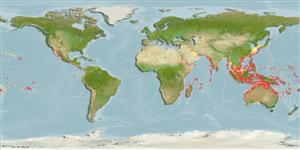Common names from other countries
>
Kurtiformes (Nurseryfishes, cardinalfishes.) >
Apogonidae (Cardinalfishes) > Apogoninae
Etymology: Siphamia: A Swazi word, siphama, for a fish.
More on author: Weber.
Environment: milieu / climate zone / depth range / distribution range
Ecologia
marinhas associadas(os) a recifes; intervalo de profundidade 0 - 100 m (Ref. 90035), usually 1 - 18 m (Ref. 90102). Tropical
Indo-West Pacific: from the Red Sea south to Madagascar and east through the Maldives, Sri Lanka and India to the Andaman Sea Islands and Western Australia; north to Ryukyus; throughout the Indo-Malayan region to Vanuatu.
Tamanho / Peso / Idade
Maturity: Lm ? range ? - ? cm
Max length : 7.0 cm TL macho/indeterminado; (Ref. 89972)
Descrição suscinta
Morfologia | Morfometria
Espinhos dorsais (total): 8; Raios dorsais (total): 9; Espinhos anais 2; Raios anais : 8. This species is distinguished by the following characters: D1 VII, D2 I,9; A II,8; pectoral fin rays 14-16; tubed lateral-line scales 20-24; median predorsal scales 4 (rarely 3 or 5); total gill rakers 2-4 + 8-10 = 11-14; developed gill rakers 1 + 7-9; gill rakers on ceratobranchial 7-8; body depth 2.3-2.7 in SL and body width 1.9-2.2 in the depth; eye diameter 2.6-3.5 in HL; first dorsal spine 2.4-4.6 in second spine; second dorsal spine 3.7-6.6, second dorsal fin spine 3.7-5.4, second anal spine 5.0-7.0, all in head length; pectoral-fin length 4.2-5.3 and pelvic-fin length 4.2-4.7 in SL; caudal peduncle length 1.5-2.1 in distance between pelvic spine insertion and anal-fin origin; preopercular edge with 23-35 serrations, the preopercular ridge smooth; scales mostly spinoid, but some cycloid scales on anterior part of body; vomer and palatines with 1-2 series of small teeth, but palatines sometimes toothless; tip of light organ on each side of tongue bound by membrane (Ref. 90035).
Found in coastal reefs and outer reef lagoons. This species forms small groups with long-spined urchins (Ref. 48635) (e.g. Diadema setosum in shallow sheltered waters, Ref. 1602); but was also found among the spines of Acanthaster planci (Ref. 90035). Feeds on zooplanktons and small invertebrates (Ref. 89972).
Ciclo de vida ou comportamento de acasalamento
Maturidade | Reprodução | Desova | Ovos | Fecundidade | Larvas
Distinct pairing during courtship and spawning (Ref. 205).
Gon, O. and G.R. Allen, 2012. Revision of the Indo-Pacific cardinalfish genus Siphamia (Perciformes: Apogonidae). Zootaxa 3294:1-84. (Ref. 90035)
Status na Lista Vermelha da UICN (Ref. 130435)
CITES (Ref. 128078)
Not Evaluated
Ameaça para os humanos
Harmless
Uso pelos humanos
Mais informação
Idade/TamanhoCrescimentoPeso-comprimentoComprimento-comprimentoFrequências de comprimentoMorfometriaMorfologiaLarvasDinâmica larvalRecrutamentoAbundância
ReferênciasAquaculturaPerfil para aquaculturaEstirpesGenéticaElectrophoresesHereditariedadeDoençasProcessamentoConversão de massa
ColaboradoresFotosStamps, Coins Misc.SonsCiguateraVelocidadeTipo de nataçãoÁrea branquialOtólitosCérebrosVisão
Ferramentas
Relatórios especiais
Baixar XML
Fontes da internet
Estimates based on models
Preferred temperature (Ref.
115969): 24.6 - 29.2, mean 28.3 (based on 4132 cells).
Índice de diversidade filogenética (Ref.
82804): PD
50 = 0.5000 [Uniqueness, from 0.5 = low to 2.0 = high].
Bayesian length-weight: a=0.01479 (0.00690 - 0.03171), b=3.09 (2.91 - 3.27), in cm Total Length, based on LWR estimates for this (Sub)family-body shape (Ref.
93245).
Nível Trófico (Ref.
69278): 3.5 ±0.50 se; based on food items.
Resiliência (Ref.
120179): Elevada, tempo mínimo de duplicação da população menor que 15 meses (Preliminary K or Fecundity.).
Fishing Vulnerability (Ref.
59153): Low vulnerability (10 of 100).
